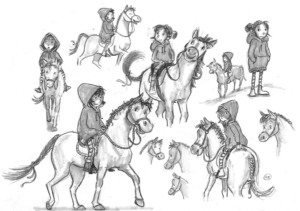
This article is in the Windows into Illustration Category
Windows into Illustration: David Melling
Perhaps best known for his hugely popular Hugless Douglas series, David Melling has been illustrating children’s books since 1993, creating over 150 books. The Kiss That Missed, the first book he wrote as well as illustrated, was shortlisted for the Kate Greenaway Medal. In this article he describes how using digital technology is bringing something new to his work.
I’ve always been a bit of a technophobe. Throughout my 30 years in children’s publishing I’ve used the same techniques and traditional materials of pen, ink and watercolour. Yet in recent years, I was becoming more aware I was asking designers to help make small changes or corrections digitally to an original illustration that might otherwise need re-doing. Despite my reservations, I realised that if I was asking someone else to help me digitally I should at least have some awareness and knowledge myself about how this could be achieved. Until only a few years ago, I literally had no idea.
After a couple of evening courses, together with some advice and tips from friends, my knowledge improved. Unexpectedly, I found myself thinking differently about how I might approach an illustration, using Photoshop in a more significant way and not just as a correcting tool.
 The opportunity to develop this new way of working came when I began work on Goldilocks and the Three Crocodiles by Michael Rosen and has continued with Not-so-Little Red Riding Hood, which is where this illustration features. It’s been a steep learning curve. Fortunately, I’ve had a patient and supportive team at HarperCollins who’ve kept faith with me throughout the process.
The opportunity to develop this new way of working came when I began work on Goldilocks and the Three Crocodiles by Michael Rosen and has continued with Not-so-Little Red Riding Hood, which is where this illustration features. It’s been a steep learning curve. Fortunately, I’ve had a patient and supportive team at HarperCollins who’ve kept faith with me throughout the process.
For me, everything starts with a pencil; designing characters and moving them around on the paper. 
 Next, are the pencils roughs and the opportunity to add little details not necessarily in the text. In this case, I thought it would be fun to have the more contemporary wolf in the story navigating the forest on a scooter.
Next, are the pencils roughs and the opportunity to add little details not necessarily in the text. In this case, I thought it would be fun to have the more contemporary wolf in the story navigating the forest on a scooter.
 The next stage is where things have changed in my process. Where once, I used to carefully trace the drawing (using a lightbox), onto watercolour paper, I now start creating textures (trees, foliage etc), using a range of materials; watercolour, charcoal, pencil, etc. [image 4]
The next stage is where things have changed in my process. Where once, I used to carefully trace the drawing (using a lightbox), onto watercolour paper, I now start creating textures (trees, foliage etc), using a range of materials; watercolour, charcoal, pencil, etc. [image 4]
These textures are scanned, along with the original pencil sketch, and composed (using some digital brushes too), in Photoshop. A sort of a digital collage.
 Somewhere along the way, it was decided that Little Red should be looking and pointing at a sound off stage. This was easily corrected by drawing a new arm and adding it digitally. [image 5]
Somewhere along the way, it was decided that Little Red should be looking and pointing at a sound off stage. This was easily corrected by drawing a new arm and adding it digitally. [image 5]
Once the final piece had been done, a late narrative issue cropped up which meant, sadly, that the wolf could not be shown in this image. Again, another time saver, as I simply deleted the layer (seconds!), whereas I almost certainly would have had to re-do the colour piece from scratch.
Working digitally has certainly brought something new to my work. And I’ve found one unexpected extra bonus; the option to use my looser, pencil sketches (usually just roughs), into my final artwork. (When you trace a sketch, you always loose that spontaneous line). It’s a work in progress but, much to my surprise, I’ve managed to find a new way of combining analogue and digital techniques – the best of both worlds! I would never have believed that not so long ago.
Goldilocks and the Three Crocodiles and Not-so-Little Red Riding Hood by Michael Rosen, illustrated by David Melling, are published by HarperCollins Children’s Books, £7.99 pbk and £12.99 hbk respectively.





